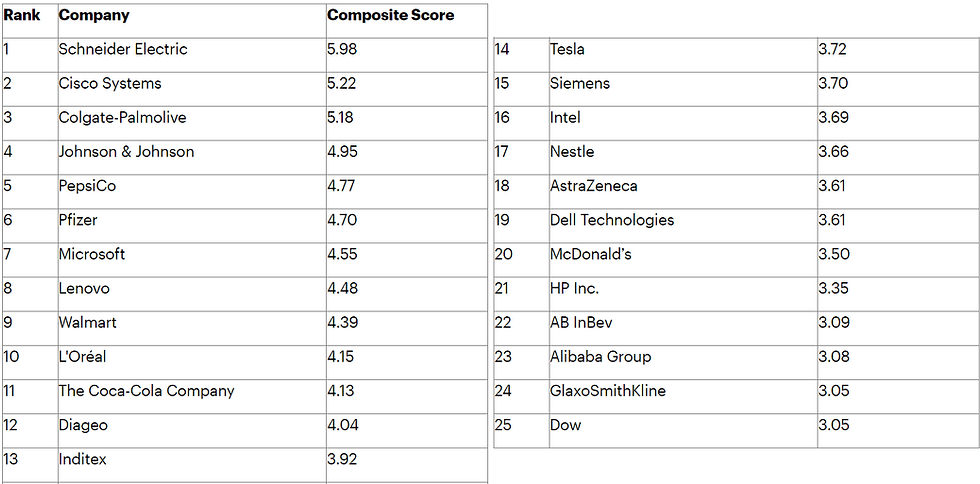Gartner Announces Rankings of the 2023 Global Supply Chain Top 25
Schneider Electric Claims Top Position While Tesla Makes List Debut

Gartner, Inc. has released the results from its annual Global Supply Chain Top 25, identifying leading supply chain organizations, highlighting trends and sharing best practices.
"The leading companies on our list are notable for pursuing new avenues of growth at a time when disruptions remain a near constant threat," said Mike Griswold, vice president team manager with the Gartner Supply Chain practice. “The best supply chain organizations are embracing the moment by both pursuing growth, while also evolving more sophisticated risk management approaches.”
Schneider Electric claimed the top position in the list this year, followed in second place by Cisco Systems, which capped a run of three consecutive years in the top position last year. Colgate-Palmolive, Johnson & Johnson and PepsiCo rounded out the top five positions. Tesla, AB Inbev, GlaxoSmithKline and Dow were the new entrants on the list (See Figure 1).
"Schneider Electric’s work embodies multiple trends we see among top supply chain organizations this year, such as embracing an ecosystem approach that has helped reduce the carbon footprint of some key suppliers by 10% in less than two years,” Griswold said. “Sustainability continues to be front and center for the members of our list, with 19 companies once again achieving perfect ESG scores.”
Gartner continues to recognize sustained supply chain performance via the “Masters” category, introduced in 2015. To be considered Masters, companies must have attained top-five composite scores for at least seven out of the last 10 years. Amazon, Apple, P&G and Unilever all qualified for the category this year.
Figure 1. The Gartner Supply Chain Top 25 for 2023

Note: Composite Score: (Peer Opinion*25%) + (Gartner Research Opinion*25%) + (ROPA*15%) + (Inventory Turns*5%) + (Revenue Growth*10%) + (ESG Component Score*20%)
Source: Gartner (May 2023)
For 2023, the Top 25 and Masters companies embraced three trends:
Identifying and Capturing New Opportunities
Supply chain leaders may feel caught between the CEO’s imperative to drive growth while their CFO seeks stability and a heightened focus on risk management amid a volatile economic environment. The best supply chain organizations are positioning themselves as a partner for growth, while also seeking to master supply chain risks.
“The most advanced supply chains are investing in being stronger and more profitable than their competitors in turbulent times,” said Griswold. “An antifragile strategy that supports rapid mitigation and recovery from existing disruptions, as well as the ability to anticipate and avoid future supply risks also provides a platform to exploit new opportunities for growth.”
Driving Individual and Collective Progress
CSCOs are achieving high priority objectives by shifting from one-to-many networks to many-to-many ecosystems. These leaders are developing partnering and data sharing capabilities while shaping mindsets, and governance to build enterprise-, platform- and purpose-centric ecosystems founded on trust.
The ecosystem trend is most evident in areas including net-zero emissions goals, regenerative agriculture and supporting living wages throughout an organization’s global supply chain network. The use cases where these types of many-to-many ecosystems are required for scale and progress will only increase over time. A significant challenge looming on the horizon relates to standards for the build out of nationwide charging grids for electric vehicles.
Transforming the Way Their Organizations Work
Among the most mature global supply chains, the term “connected” is being applied to customers, suppliers, partners and their employees.
Supply chain leaders are altering the ways employees approach their jobs by leveraging various technology solutions. These allow workers to maintain awareness of their environments through alerts and performance management, to boost productivity through physical and logical automation, and drive innovation and collaboration with others through connected platforms. Many of them consider the machines working alongside and in support of human workers to be an extension of their workforce.
Significant investments have been made in developing and automating sensors on factory and warehouse floors over the past few years. Several are using automation, digitalization and analytics to drive higher efficiency and product quality in these environments.




































Comentarios